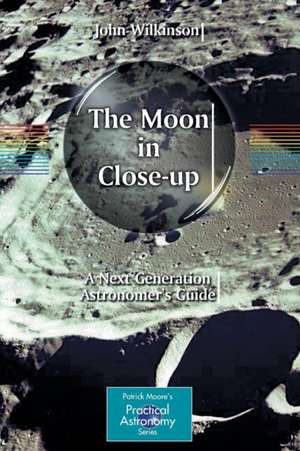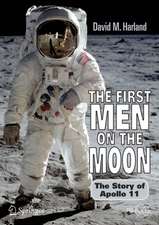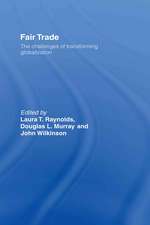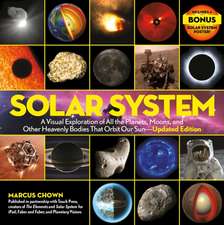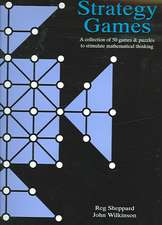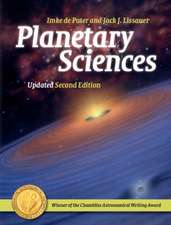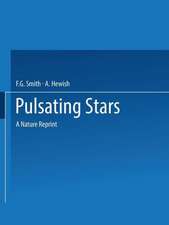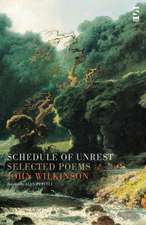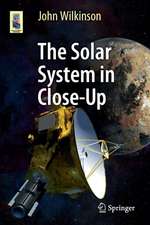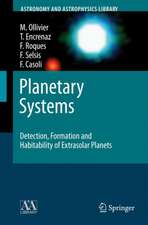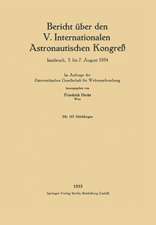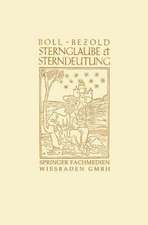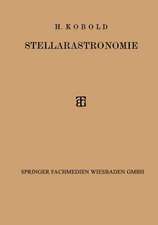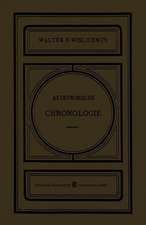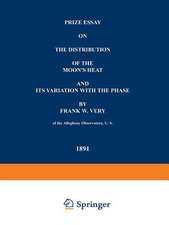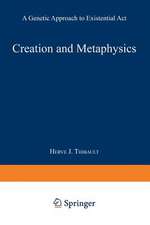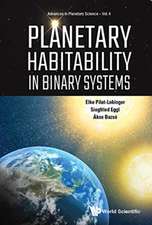The Moon in Close-up: A Next Generation Astronomer's Guide: The Patrick Moore Practical Astronomy Series
Autor John Wilkinsonen Limba Engleză Paperback – 4 ian 2011
Din seria The Patrick Moore Practical Astronomy Series
-
 Preț: 258.21 lei
Preț: 258.21 lei -
 Preț: 164.94 lei
Preț: 164.94 lei -
 Preț: 324.21 lei
Preț: 324.21 lei -
 Preț: 255.10 lei
Preț: 255.10 lei - 8%
 Preț: 581.98 lei
Preț: 581.98 lei -
 Preț: 159.16 lei
Preț: 159.16 lei -
 Preț: 282.38 lei
Preț: 282.38 lei -
 Preț: 308.55 lei
Preț: 308.55 lei -
 Preț: 309.87 lei
Preț: 309.87 lei -
 Preț: 332.98 lei
Preț: 332.98 lei -
 Preț: 276.91 lei
Preț: 276.91 lei -
 Preț: 243.94 lei
Preț: 243.94 lei -
 Preț: 183.40 lei
Preț: 183.40 lei -
 Preț: 378.09 lei
Preț: 378.09 lei -
 Preț: 302.20 lei
Preț: 302.20 lei -
 Preț: 210.01 lei
Preț: 210.01 lei -
 Preț: 212.68 lei
Preț: 212.68 lei -
 Preț: 271.39 lei
Preț: 271.39 lei -
 Preț: 252.91 lei
Preț: 252.91 lei -
 Preț: 281.95 lei
Preț: 281.95 lei -
 Preț: 289.85 lei
Preț: 289.85 lei -
 Preț: 218.84 lei
Preț: 218.84 lei -
 Preț: 282.38 lei
Preț: 282.38 lei -
 Preț: 128.86 lei
Preț: 128.86 lei -
 Preț: 301.10 lei
Preț: 301.10 lei -
 Preț: 204.78 lei
Preț: 204.78 lei -
 Preț: 307.44 lei
Preț: 307.44 lei -
 Preț: 303.07 lei
Preț: 303.07 lei -
 Preț: 258.83 lei
Preț: 258.83 lei -
 Preț: 155.25 lei
Preț: 155.25 lei -
 Preț: 193.97 lei
Preț: 193.97 lei -
 Preț: 208.26 lei
Preț: 208.26 lei -
 Preț: 279.09 lei
Preț: 279.09 lei -
 Preț: 303.51 lei
Preț: 303.51 lei -
 Preț: 277.54 lei
Preț: 277.54 lei -
 Preț: 208.51 lei
Preț: 208.51 lei -
 Preț: 214.86 lei
Preț: 214.86 lei -
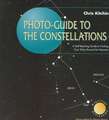 Preț: 304.58 lei
Preț: 304.58 lei -
 Preț: 220.57 lei
Preț: 220.57 lei -
 Preț: 157.32 lei
Preț: 157.32 lei -
 Preț: 275.98 lei
Preț: 275.98 lei -
 Preț: 288.98 lei
Preț: 288.98 lei -
 Preț: 261.49 lei
Preț: 261.49 lei -
 Preț: 279.09 lei
Preț: 279.09 lei -
 Preț: 160.82 lei
Preț: 160.82 lei -
 Preț: 327.01 lei
Preț: 327.01 lei -
 Preț: 254.90 lei
Preț: 254.90 lei -
 Preț: 304.38 lei
Preț: 304.38 lei -
 Preț: 256.84 lei
Preț: 256.84 lei
Preț: 258.21 lei
Nou
Puncte Express: 387
Preț estimativ în valută:
49.41€ • 51.59$ • 40.80£
49.41€ • 51.59$ • 40.80£
Carte disponibilă
Livrare economică 25 martie-08 aprilie
Preluare comenzi: 021 569.72.76
Specificații
ISBN-13: 9783642148040
ISBN-10: 3642148042
Pagini: 300
Ilustrații: XI, 310 p. 57 illus. in color.
Dimensiuni: 155 x 235 x 17 mm
Greutate: 0.52 kg
Ediția:2011
Editura: Springer Berlin, Heidelberg
Colecția Springer
Seria The Patrick Moore Practical Astronomy Series
Locul publicării:Berlin, Heidelberg, Germany
ISBN-10: 3642148042
Pagini: 300
Ilustrații: XI, 310 p. 57 illus. in color.
Dimensiuni: 155 x 235 x 17 mm
Greutate: 0.52 kg
Ediția:2011
Editura: Springer Berlin, Heidelberg
Colecția Springer
Seria The Patrick Moore Practical Astronomy Series
Locul publicării:Berlin, Heidelberg, Germany
Public țintă
Popular/generalCuprins
Introducing the Moon.- Probing the Moon.- Geological history of the Moon.- Occultations and eclipses.- Observing the Moon.- Studying the Moon: Study Area 1 – Mare Crisium.- Study Area 2 – South east limb.- Study Area 3 – North east limb.- Study Area 4 – Mare Tranquillitatis.- Study Area 5 – Mare Serenitatis.- Study Area 6 – Mare Nectaris west.- Study Area 7 – Mare Vaporum.- Study Area 8 – Central Highlands.- Study Area 9 – Mare Nubium.- Study Area 10 – Northern Plains.- Study Area 11 – Southern Highlands.- Study Area 12 – Mare Cognitum.- Study Area 13 – Sinus Iridum.- Study Area 14 – Mare Insularum.- Study Area 15 – Mare Humorum.- Study Area 16 – Oceanus Procellarum.- Study Area 17 – Western limb.- Glossary.
Recenzii
From the reviews:
“The book is in paperback and is very well presented with many illustration in colour as well as black and white. … contains six chapters but the last chapter is divided into 17 sections. … Overall I recommend this book as one of the most useful for amateur astronomers. … book is a practical guide to observing the moon. It is most useful for people wanting information on the latest findings.” (Jenny Ball, IceInSpace, May, 2011)
“Divided into six chapters, there’s something for everyone interested in our natural satellite here. Chapter one discusses the Moon’s orbit, libration, phases and topography. The following two chapters cover space missions and geological history. Occultations, eclipses and observing complete the first half of the book, which together make a great beginner’s introduction. Chapter six studies individual features in great detail … .” (Steve Richards, Sky at Night Magazine, September, 2011)
“Science instructor/writer Wilkinson does a good job of making the moon accessible to amateur astronomers and beginners … . The index and glossary are well done, and most of the figures are good … . Overall, this book might be useful for nonscience undergraduate students taking an introductory astronomy class. Summing Up … Lower-division undergraduates and general readers.” (J. R. Kraus, Choice, Vol. 49 (3), November, 2011)
“The book is in paperback and is very well presented with many illustration in colour as well as black and white. … contains six chapters but the last chapter is divided into 17 sections. … Overall I recommend this book as one of the most useful for amateur astronomers. … book is a practical guide to observing the moon. It is most useful for people wanting information on the latest findings.” (Jenny Ball, IceInSpace, May, 2011)
“Divided into six chapters, there’s something for everyone interested in our natural satellite here. Chapter one discusses the Moon’s orbit, libration, phases and topography. The following two chapters cover space missions and geological history. Occultations, eclipses and observing complete the first half of the book, which together make a great beginner’s introduction. Chapter six studies individual features in great detail … .” (Steve Richards, Sky at Night Magazine, September, 2011)
“Science instructor/writer Wilkinson does a good job of making the moon accessible to amateur astronomers and beginners … . The index and glossary are well done, and most of the figures are good … . Overall, this book might be useful for nonscience undergraduate students taking an introductory astronomy class. Summing Up … Lower-division undergraduates and general readers.” (J. R. Kraus, Choice, Vol. 49 (3), November, 2011)
Notă biografică
John Wilkinson is a science educator with over 30 years experience in teaching science, physics and chemistry in secondary colleges and universities in Australia. He is author of over 100 science textbooks. He completed his Masters degree and PhD in science education at La Trobe University, Australia. Throughout his life he has been a keen amateur astronomer and operates his own observatory from his backyard.
Textul de pe ultima copertă
Information collected by recent space probes sent to explore the Moon by the USA, the European Space Agency, Japan, China and India has changed our knowledge and understanding of the Moon, particularly its geology, since the Apollo missions. This book presents those findings in a way that will be welcomed by amateur astronomers, students, educators and anyone interested in the Moon. Enhanced by many colour photos, it combines newly acquired scientific understanding with detailed descriptions and labelled photographic maps of the lunar surface. Guided by observation methods explained in the book and 17 Study Areas presented and carefully explained in the last chapter, amateur astronomers can observe these features from Earth using telescopes and binoculars. Readers who consult the photographic maps will gain a better understanding about the Moon’s topography and geology. The book is rounded out by a helpful glossary.
Caracteristici
Explains the latest understanding of lunar features and geology, based on the most recent space missions and analysis Highlights ‘what’s new’ in our knowledge at the start of each chapter Offers detailed techniques and tips on how to observe interesting features of the Moon, with telescopes and binoculars Organized into 17 study areas, with a photographic maps and rich descriptions of all the features in each area
